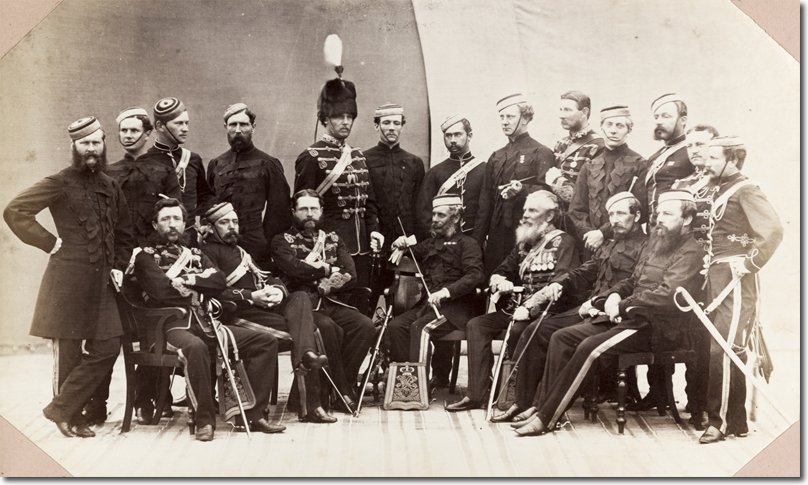|
|


|
|
This photo was taken at Campbellpore in India in 1866 and shows various forms of dress and undress worn by the officers of the 20th Hussars. Some of them are in dress uniforms, showing the sabretache and rather baggy trousers worn at that early stage of the 'modern' hussar pattern. Only one officer wears the tall busby with a rather stunted white egret plume.This is puzzling because the 1864 Dress Regulations state that the 20th had a crimson plume. The only regiments that wore a bi-colour plume, as seen here, were the 8th, 10th and 11th Hussars, however, the pouch-belt he wears is light dragoon pattern and does not belong to any of those regiments. He is a captain as can be seen by the star and crown badges on his collar. There were no shoulder cords until 1881, and the chain gimp across the chest has smaller loops and drops than the later style. The undress forage caps are of interest because they show the development from rather soft shapeless items to the more rigidly formed pill-box.
The sleeve decoration on the dress tunics that we can see is mostly for the rank of captain. The Austrian knots are surrounded by Russia braid circlets. One distinguished-looking officer sporting a white beard and four medals has field rank sleeve decoration which at this stage is relatively modest. He seems to have a star and a crown badge on his collar which indicates that he is a full colonel. He may well be the honorary Colonel of the regiment, Lt-General Charles Montauban Carmichael CB, but there is no sign of his Order of the Bath decoration. He sits next to the CO who looks the other way. He must be Henry Stannus CB who commanded from 1862 to 73. He wears a blue frock coat with black flat braid. Seven others are wearing similar frock coats. Only one man, sitting on the right, is wearing the shorter patrol jacket which is blue with black cord braiding. Stable jackets are worn by five of the officers. The short man standing on the extreme right shows the gold braid decoration on the side of the jacket, normally hidden under the arm. He has a sword, minus sword-knot, and a plain black leather sabretache. Other recognisable figures in the picture are future COs Robert Alexander standing on the left, Charles Cotton seated on the left, Frederick Chevenix-Trench standing in the middle beside the man in the busby, and Cecil Mangles next to him. Seated next to Cotton is Riding Master Willis and next to Mangles is Lieutenant Arthur Broadhurst. Next to Broadhurst is the regimental surgeon Captain Cuningham. He shows his rank on his collar and his sleeve, and wears a plain leather pouch belt with a Medical Department badge on the front. Lieutenant David Budd is next to Cuningham. A similar informal group photograph of many of these individuals was also taken at the same time. Image Courtesy of Ben Giffard |
Armed Forces | Art and Culture | Articles | Biographies | Colonies | Discussion | Glossary | Home | Library | Links | Map Room | Sources and Media | Science and Technology | Search | Student Zone | Timelines | TV & Film | Wargames